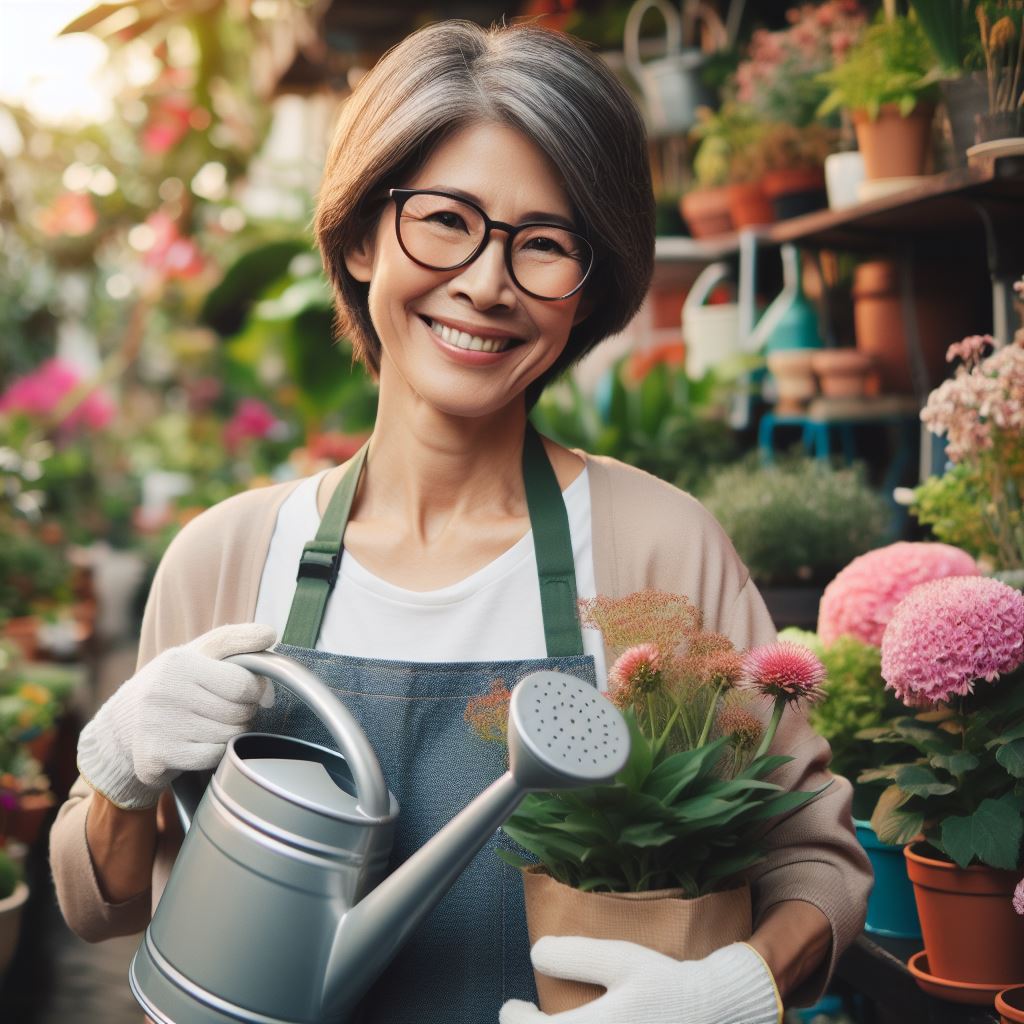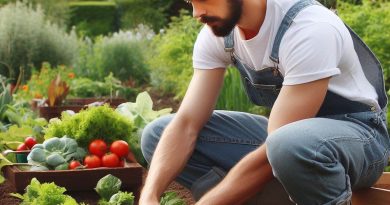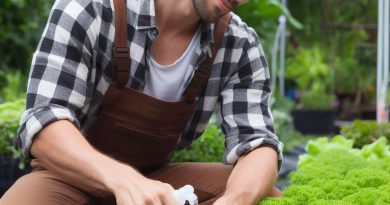Container Gardening Tools for Urbanites
Last Updated on February 8, 2024
Introduction
Container gardening
Container gardening is a method of growing plants in pots or containers, rather than in the ground.
With containers, gardening becomes accessible to those with limited outdoor space, enabling the growth of flowers, herbs, and vegetables on balconies, patios, or windowsills.
It provides an opportunity for urbanites to engage in gardening and enjoy fresh produce.
With container gardening, anyone can enjoy the benefits of gardening, regardless of their living situation.
Growing popularity of container gardening among urbanites
There is a growing trend among urbanites to engage in container gardening due to its numerous advantages.
It provides city dwellers with the opportunity to connect with nature, grow their own food, and beautify their surroundings.
Container gardening also offers a sense of fulfillment and relaxation.
Importance of having the right tools for successful container gardening
Having the right tools is essential for successful container gardening.
Tools such as a trowel, pruners, watering can, and gloves help in planting, maintaining, and nurturing the plants.
Choosing the right-sized containers, soil, and fertilizers are equally important for optimal plant growth and health.
In essence, container gardening is a popular choice among urbanites as it allows them to enjoy gardening in limited spaces.
To ensure success, it is crucial to have the right tools and materials for container gardening.
By investing in the appropriate tools, urban gardeners can create a thriving and beautiful garden in their own urban oasis.
Essential Container Gardening Tools
Container gardening in urban areas can bring a green touch to limited spaces and add a sense of nature to concrete surroundings.
However, to ensure success and maximize the potential of container plants, it’s important to have the right tools at hand.
Here are some essential container gardening tools every urbanite should consider:
Potting Soil
Using quality potting soil is crucial for the overall health and growth of container plants.
It provides essential nutrients and promotes proper drainage, preventing waterlogged roots.
When selecting potting soil, it’s best to opt for peat-based, compost-based, or soil-less mixes specifically designed for container gardening.
Containers
Choosing the right containers is essential for the success of container gardening.
Consider the size of the plant, its root system, and its growth potential when selecting containers.
Different materials like clay, plastic, and wood offer unique benefits.
Clay containers provide excellent insulation and breathability for plants, while plastic containers are lightweight and retain moisture better.
Wood containers add a rustic aesthetic and offer good insulation.
Hand Trowel
A hand trowel is a versatile, handheld tool that assists in planting and maintaining container plants.
It helps dig holes, transplant seedlings, and remove weeds. When choosing a hand trowel, consider its handle grip, blade size for precise digging, and overall durability.
Pruning Shears
Pruning shears are essential for maintaining the health and shape of container plants.
They allow for the trimming of dead or damaged foliage, promoting new growth and preventing diseases.
Different types of pruning shears, such as bypass shears, anvil shears, and ratchet pruners, cater to various pruning needs.
Watering Can or Hose
Proper watering techniques are crucial for the success of container gardening.
Overwatering or underwatering can harm plants.
Choose between a watering can or a hose based on the size of the containers and the availability of a water source.
A watering can is ideal for precise watering and smaller spaces, while a hose is suitable for larger containers and areas.
Gardening Gloves
Gardening gloves protect hands from thorns, sharp edges, and soil-borne bacteria.
They provide grip and prevent blisters during tasks such as planting, pruning, and weeding.
Consider the materials, fit, and level of protection desired when selecting gardening gloves.
Plant Markers
Keeping track of plant names and varieties is essential, especially when maintaining multiple container plants.
Plant markers help identify plants and prevent confusion.
Choose between DIY plant markers using materials like popsicle sticks or stones, or opt for store-bought options such as plastic or metal markers.
In general, having the essential container gardening tools can make a significant difference in the success and enjoyment of urban container gardening.
Investing in quality potting soil, choosing suitable containers, and utilizing tools like hand trowels, pruning shears, watering cans or hoses, gardening gloves, and plant markers will help urbanites create thriving and aesthetically pleasing container gardens.
Read: Smart Watering: Techniques for Small-Scale Farms
Optional Container Gardening Tools
Having the right tools can make a significant difference in the success of your container gardening endeavors.
While basic tools like trowels and pruners are essential, there are optional tools specifically designed to enhance your gardening experience.
In this section, we will explore several optional container gardening tools that can further elevate your urban gardening adventures.
Hand Cultivator
When it comes to maintaining healthy soil in containers, a hand cultivator is a must-have tool.
Its primary function is to aerate the soil and break up clumps, allowing better air circulation and drainage.
Additionally, it helps remove weeds and cultivate the soil, promoting root growth and nutrient absorption for your plants.
When selecting a hand cultivator, consider the handle’s comfort, material durability, and the type and number of tines that suit your specific needs.
Plant Dolly
Moving heavy containers can be a challenging task, especially for urban gardeners with limited space.
A plant dolly is a game-changer in this regard. It is essentially a wheeled platform that allows you to effortlessly transport heavy containers from one location to another.
By using a plant dolly, you can avoid straining your back and muscles, making it easier to rearrange your container garden as needed.
When choosing a plant dolly, consider factors like weight capacity, wheel quality, and locking mechanisms.
Soil Moisture Meter
Proper watering is crucial for the success of container plants.
A soil moisture meter can help you accurately monitor the moisture levels in your containers, preventing overwatering or underwatering.
This tool typically consists of a probe that you insert into the soil to measure its moisture content.
By using a soil moisture meter, you can avoid the common pitfalls of guesswork and ensure your plants receive the right amount of water at the right time.
Fertilizer or Compost
Container plants rely on you to provide essential nutrients they would naturally obtain from the ground in traditional gardens.
Fertilizers or compost play a vital role in meeting these nutrient requirements.
Before choosing a fertilizer or compost, consider factors such as the specific nutrient composition, application frequency, and the specific needs of your plants.
Organic options are also available for those who prefer natural and eco-friendly gardening practices.
Overall, while container gardening can already be a fulfilling and rewarding experience with basic tools, optional tools can elevate it to another level.
A hand cultivator aids in soil aeration and maintaining a healthy growing environment.
A plant dolly makes moving heavy containers a breeze, saving you from unnecessary physical strain.
A soil moisture meter ensures the optimal watering needs of your plants are met accurately.
Finally, fertilizers or compost provide essential nutrients for robust plant growth. Invest in these optional tools to maximize your urban container gardening success.
Read: Rainwater Harvest: A Boon for Urban Gardeners
Maintaining and Storing Container Gardening Tools
When it comes to maintaining and storing container gardening tools, cleanliness and organization are key.
Gardening tools can easily spread diseases and pests if not properly cleaned and disinfected.
Furthermore, proper storage ensures easy access and protects tools from damage and rust.
Cleaning and disinfecting tools
Cleaning and disinfecting gardening tools should be a regular practice to prevent the spread of diseases and pests.
Different tools require different cleaning methods.
For example, pruning shears may need thorough scrubbing and sanitizing, while hand trowels may only require a quick rinse.
Proper methods for cleaning different tool
To clean gardening tools, start by removing dirt and debris.
Use a brush or cloth to scrub the tool’s surface, removing any remaining soil.
Then, sanitize the tools by wiping them with a solution of water and bleach or using commercial disinfectants.
Make sure to follow product instructions for proper dilution and contact time.
Proper storage of tools
When it comes to storage, organizing tools is essential for easy access and efficient use.
Consider using a pegboard or wall-mounted rack to hang tools on hooks.
This prevents them from getting lost or damaged in cluttered sheds or containers.
Alternatively, invest in a tool organizer or box with compartments to keep everything neatly arranged.
Protecting tools from damage and rust
Protecting tools from damage and rust is crucial for their longevity and effectiveness in container gardening.
To protect tools from damage and rust, consider these tips:
- Clean and dry tools before storage to prevent moisture buildup and rust formation.
- Apply a thin coat of oil on metal tools to create a protective barrier against moisture and rust.
- Store tools in a dry and well-ventilated area to avoid humidity and moisture-related damage.
- Hang tools or use racks to prevent unnecessary contact with moisture or other tools that may cause damage.
Regularly inspect tools for any signs of wear or damage. Replace or repair any broken or worn-out parts to maintain their efficiency.
This includes sharpening blades, tightening screws, and replacing handles when necessary.
By following proper cleaning and storage methods, container gardeners can ensure their tools remain in good condition and are ready for use whenever needed.
Taking these steps not only prolongs the lifespan of gardening tools but also contributes to the success of urban container gardening.
Read: Drip Irrigation: Small Farm Water-Saving Guide

Conclusion
Recap of essential container gardening tools
In order to successfully engage in container gardening, urbanites need to have a few key tools at their disposal.
These include:
- Planters and pots of various sizes
- High-quality potting soil
- Gardening gloves and hand trowel
- Watering can or hose with a spray nozzle
- Fertilizer for potted plants
- Pruning shears or scissors
Benefits of using the right tools for successful container gardening
Using the appropriate tools for container gardening can lead to numerous benefits:
- Efficient use of limited space in urban environments
- Increased chances of successful plant growth and healthier plants
- Easier maintenance and care for container gardens
- Ability to customize and create beautiful plant arrangements
Encouragement for urbanites to explore container gardening using the outlined tools
Even in limited urban spaces, container gardening offers a chance to connect with nature, enjoy fresh produce or vibrant flowers, and find relaxation in tending to plants.
By investing in the essential tools for container gardening, urbanites can experience the joy and benefits of gardening no matter where they live.


